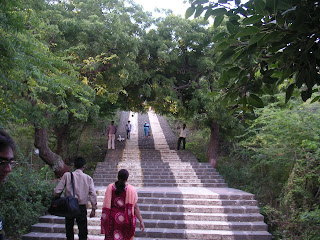


 The nightly bus ride from Hospet to Goa's capital Panjim (or Panaji, as it is also known) proved to provide an endless array of jokes on the format "How many Israelis does it take to get off a bus?" and "How much time do x Israelis need to get off a bus and what will be their decibel level as they go along?" Goa is obviously a long-time favorite among backpackers and the bus made several stops along the way. These people were quite the stereotypes. Rasta plaits, cargo pants and mini drums in bands across the chest, which they to my regret enjoyed playing in the middle of the night. One was even wearing a t-shirt with the text "God created grass, man created booze. Who do you trust?". I would argue God also created toadstools, however that does not mean I intend to consume them. What troubled me the most, though, was the way one (the gentleman in the marijuana t-shirt) treated some beggars in Hospet. Yes, sometimes I too think beggars are annoying, but that does not in any way justify a condescending behaviour of yelling "shoo, shoo" with eyes wide open and accompanying hand gestures. It is, to put it mildly, not the way to behave when you are a guest in somebody else's country.
The nightly bus ride from Hospet to Goa's capital Panjim (or Panaji, as it is also known) proved to provide an endless array of jokes on the format "How many Israelis does it take to get off a bus?" and "How much time do x Israelis need to get off a bus and what will be their decibel level as they go along?" Goa is obviously a long-time favorite among backpackers and the bus made several stops along the way. These people were quite the stereotypes. Rasta plaits, cargo pants and mini drums in bands across the chest, which they to my regret enjoyed playing in the middle of the night. One was even wearing a t-shirt with the text "God created grass, man created booze. Who do you trust?". I would argue God also created toadstools, however that does not mean I intend to consume them. What troubled me the most, though, was the way one (the gentleman in the marijuana t-shirt) treated some beggars in Hospet. Yes, sometimes I too think beggars are annoying, but that does not in any way justify a condescending behaviour of yelling "shoo, shoo" with eyes wide open and accompanying hand gestures. It is, to put it mildly, not the way to behave when you are a guest in somebody else's country.
Upon arriving in Panjim, we were immediately stricken by the beauty of the town. By all Indian standards, it is clean, quiet and well behaved. The Portuguese heritage is extremely visible in everything from churches, secular architecture, clothes (especially the females') and, dare I say, mentality. This is not at all odd, considering the Portuguese did not leave (or rather, they were kicked out) until 1961. Panjim truly is a natural pearl among Indian cities.
After too much looking (thank you again, LP incomprehensible maps...) we found a very pleasant guesthouse, where we had planned to spend the night. After the best breakfast I have had since arriving in India (there was coffee, and no loads of added milk and sugar...) we set out to see Old Goa, the former capital, 25 minutes away by bus. Back in the days, this was no tiny colonial outpost; in fact, it had more inhabitants than both London and Lisbon. Due to some nasty and unfortunately recurrent outbreaks of malaria, it was however abandoned in 1835 and became what is best described as a ghost town (though it has lately been revived a little). Quite a spectacular one, I would imagine, considering that it is home to some pretty impressive buildings, including the Sé Cathedral - apparently the largest church in all of Asia. There is also the Basilica of Bom Jesus (which holds the remains of St. Francis Xavier), the Church of St. Francis of Assissi, the Chapel of St. Catherine and... well, to be honest there are very many churches in old Goa, but to come to their defence, they are all very beautiful. Something that moved me especially were the wrecked tombstones of 17th century Portuguese men and women, now since long forgotten, around the quiet Chapel of St. Catherine. I specifically remember one piece with a faint, though still clearly visible, fragment of a catholic bishop's crest. A peaceful and tranquilising final resting place they have been awarded. A stone's throw away lie the remarkable ruins of the town's Augustinian monastery. I have always had a soft spot for ruins of that kind and this was really one of the best I have seen.
After returning to Panjim we expored this town further, wandered its narrow streets up and down, discovered the wonderful, but tiny, Top Gear Pub and ate some truly terrific food at a hotel, the name of which I have by now forgotten. There is not much to tell about Panjim, because really it is not so much a town for exploring as for sensing. It has a rhythm of its own. It is best experienced in listening mode. A favorite of mine.
Pictured clockwise: Basilica of Bom Jesus; Panjim; Sé Cathedral; Augustinian monastery ruins





















